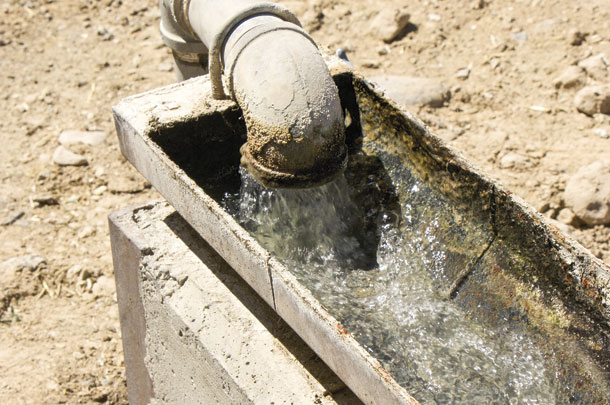After nearly 43 years of creativity, Swager decided it was finally time to implement one of his most novel ideas: a feedline water trough.
Swager believes water is of utmost importance to dairy cows, especially in climates where cows need greater opportunities to drink. With this in mind, he designed a patented water trough to serve that need. Using an excess screen from a previous project and hardware store supplies, he built a test feedline water trough in 2011 to serve a 100-cow lot on Swager Farms near Buhl, Idaho.
The flow of water
A combination of simple equipment and gravity work in tandem to deliver a steady flow of fresh water directly in front of cows while they eat at the bunk. At the top of the system is a small shed that houses a 10,000-gallon water tank and protects the water supply from environmental factors such as weather and bird contamination. Inside this shed, the temperature-controlled water is disinfected and recycled. Once a month, Swager flushes the entire system and puts in fresh water for consumption.

From the tank, gravity pulls water through an underground pipe to a controlled water spout. At that point, the water is on a continuous flow through a built-in trough that runs along the front of the headlocks. After the water has reached the end of the trough, it is sent through an underground pipeline to a screened filter. The graduated filter, which originated in British Columbia, sifts water through holes while trapping any feed spilled in the water. This filter is self-cleaning, but Swager routinely power washes it to remove bacteria.
“It’s so nice because it only takes me about 10 or 15 minutes rather than having to hire someone to clean waterers every day,” Swager says. “It’s surprising that not much feed actually runs through the troughs – but what does, the screen catches.” After this feed is collected, it is re-fed.

The only part of the waterer system not gravity-driven is the portion after the filter. The clean water is pumped back up to the water tank inside the shed and recirculated.
A meal with a drink
Swager saw a benefit in the idea of making water readily available to every individual cow while they eat. “Having water right by the feed allows cows to easily switch between eating feed and drinking water,” Swager says. “They’re like humans in that we like to rotate between the two at meals.”
With the average cow muzzle width of 6 inches, Swager designed the water trough to accommodate for each cow and extra flow space. When a cow sticks her muzzle into the trough, she is able to block the majority of the flow of water and consume a deep drink. The extra space allows water to continuously flow and carry away any access feed particles that fall into the water stream.
Swager adds that cows now have equal opportunities to consume water within their social order. With a typical water trough, dominant cows will take space at the tank, while timid animals aren’t likely to fight to reach water. Swager noticed the less dominant cows would often wait, then take in large amounts of water at once, which he says is not ideal.
With this design in place, every cow now has 2 feet of water space open to them at the headlock. This allows for more consistent consumption, according to Swager. As 10 gallons of water flow per minute through the 100-cow headlock line, any and all cows are able to drink water as they wish.
Growth in system size and cattle benefits
After a six-month test on a 100-cow lot, Swager added a water trough to two other 100-cow pens on his 4,200-cow dairy. The system currently provides water to half of a controlled herd of 600. The cows that reside on this portion of the dairy are certified A1-free, so Swager believes testing the waterer system there allows for greater attention to benefits while capitalizing on a niche market of A2A2 milk.
Swager acknowledges one of the key advantages of this system is removing the need for waterers in the corrals, thus reducing messy areas where cows typically congregate and defecate. Also, Swager has seen an increase in dry matter intake (DMI) which has led to increased milk production levels. He believes the pH levels are more consistent in the cows’ stomachs using the trough. An additional benefit is the efficiency of feed and water consumption, similar to the benefits of water bowls in stanchion barns.
With these observed benefits, Swager says he’s ready to extend the waterer system. “I’d really like to put this system in place in all of our lots and freestalls, but that will depend on the dairy economy,” Swager says. Until the time comes, Swager says he will continue to take note of small changes to make in the future.
Swager hopes to work with a company to market the patented system commercially in the future. He believes his system would be of benefit on any dairy, whether they have 100 cows or 10,000 cows.
Additional innovations incorporated
The water trough isn’t Swager’s only invention. He and his herd manager, Jordan Stebbins, worked with a Boston-based company to create a feed belt designed to precisely measure feed amounts. While the feed belt itself is not a new invention, their idea to weigh feed being carried and dumped into a feed mixer is a new concept.
Rather than having to watch a scale or estimate ration amounts, Swager’s feed belt is programmed through EZ Feed for standard measurements. When a load is dumped into the belt, the computer knows exactly how much of that commodity to allow into the mix. The materials will feed into the mixer until the precise amount has been dumped. At that point, a gate opens on the bottom of the hopper and all extra feed runs down the belt and back into the bucket.
Feed rations remain consistent from mix to mix with the use of this computer-run feed belt. “Whereas most farmers see a 5 to 7 percent fluctuation in feed rations, we get zero to 1 percent differences,” Swager says.
Within five months of using the machine to mix feed for all animals on his dairy, Swager says the machine paid for itself simply because of the precision. Rations are much more consistent, which has aided in milk production and overall feed costs.
Swager’s innovations don’t stop there. “You might laugh, but we play relaxing classical music in the freestalls for our cows,” Swager says. This idea was not on a whim; he found some existing data to support that relaxed cows perform better, and his cows have made him a believer. He adds that his employees surprisingly enjoy it too. “We’re all relaxed when listening to relaxing music, and cows are no different,” Swager says.
Between the implementation of his long-thought-of water trough idea, the scaled feed conveyer and classical music, Swager is pleased with the outcomes – both conceived and statistically proven – on his Idaho dairy. ![]()
PHOTO 1: 300 Holsteins at Swager Farms in Buhl, Idaho, are provided water via a trough designed by owner Dean Swager. The trough system provides both water and feed to animals at the headlocks.
PHOTO 2: Water is carried by gravity from a water shed through an underground pipeline into the start of the water trough.
PHOTO 3: Water drains from the troughs into a screened filter which separates out feed particles. The screen is power-washed daily to ensure cleanliness and proper use. The drained water is then pumped back into a covered holding tank at the top of the line to continue the cycle. Photos by Madison Anderson.











